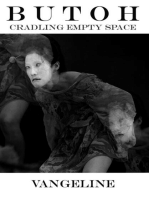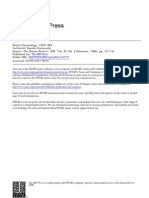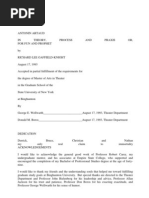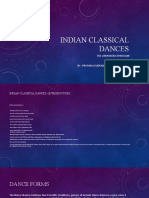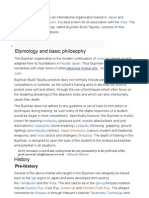Dancing and The Dark Soul of Japan - An Aesthetic Analysis of Butō
Dancing and The Dark Soul of Japan - An Aesthetic Analysis of Butō
Uploaded by
Stella Ofis AtzemiCopyright:
Available Formats
Dancing and The Dark Soul of Japan - An Aesthetic Analysis of Butō
Dancing and The Dark Soul of Japan - An Aesthetic Analysis of Butō
Uploaded by
Stella Ofis AtzemiOriginal Title
Copyright
Available Formats
Share this document
Did you find this document useful?
Is this content inappropriate?
Copyright:
Available Formats
Dancing and The Dark Soul of Japan - An Aesthetic Analysis of Butō
Dancing and The Dark Soul of Japan - An Aesthetic Analysis of Butō
Uploaded by
Stella Ofis AtzemiCopyright:
Available Formats
Dancing and the Dark Soul of Japan: An Aesthetic Analysis of "But" Author(s): Vicki Sanders Source: Asian Theatre
Journal, Vol. 5, No. 2 (Autumn, 1988), pp. 148-163 Published by: University of Hawai'i Press Stable URL: http://www.jstor.org/stable/25161489 . Accessed: 05/05/2011 09:51
Your use of the JSTOR archive indicates your acceptance of JSTOR's Terms and Conditions of Use, available at . http://www.jstor.org/page/info/about/policies/terms.jsp. JSTOR's Terms and Conditions of Use provides, in part, that unless you have obtained prior permission, you may not download an entire issue of a journal or multiple copies of articles, and you may use content in the JSTOR archive only for your personal, non-commercial use. Please contact the publisher regarding any further use of this work. Publisher contact information may be obtained at . http://www.jstor.org/action/showPublisher?publisherCode=uhp. . Each copy of any part of a JSTOR transmission must contain the same copyright notice that appears on the screen or printed page of such transmission. JSTOR is a not-for-profit service that helps scholars, researchers, and students discover, use, and build upon a wide range of content in a trusted digital archive. We use information technology and tools to increase productivity and facilitate new forms of scholarship. For more information about JSTOR, please contact support@jstor.org.
University of Hawai'i Press is collaborating with JSTOR to digitize, preserve and extend access to Asian Theatre Journal.
http://www.jstor.org
Dancing and the Dark Soul of Japan: An Aesthetic Analysis of Buto
Vicki Sanders
a poor in northeast farm boy from Akita, Tatsumi, Hijikata was a when the the atomic United States bombs teenager Japan, dropped on Hiroshima a career He intended in classical dance, but and Nagasaki. the course of Japanese just as the atomic assault forever altered political so did aftershocks mark its artists the nation's history, indelibly emerging roots from which and their attitude toward the aesthetic they sprang. cause was not antiwar, his dances Hijikata's came of age as a dancer and choreographer, however, an was in when there ruins, country lay opportunity to throw off the mantle of Westernism, class structure, redefine what of itmeant aspects "the dark 1986a, social truths is what dance tradition not antibomb. at a time when He his
a rigid to change to rediscover and
to be Japanese. One way to attack the oppressive was to expose to explore the underbelly, that hid beneath the Japanese social mask" (Stein set out Hijikata forms and entered to do when instead Donald he turned his back on that
115). That
conventional condoned Japan
an artistic
substratum
years, class-conscious unyielding, Japan its so-called the vagrants, casts, nonpeople: prostitutes, whoremongers, on and impoverished Blemishes drunks, homeless, 1986). (Richie cheek, powdered metaphor they became Hijikata's that was rejected by Japan's classical definition of beauty. In the protective shadow of the 1950s and 1960s avant-garde, white
his revolutionary for more than forty
ideas. Critic
who has lived in Richie, was to startle an aim says Hijikata's of its out into recognizing the presence the
nation's
for all
Hiji
Vicki
Miami
Sanders has been a dance and theatre critic for The Berkshire Eagle, The Providence Journal, and The In 1986 she conducted in Asian Studies at the Herald. research Fellow in Japan as a Gannett of Hawaii. University
Buto
149
a style of choreographic kata developed extremism he called ankoku buto, mean or to "dance of darkness" "dance of the dark soul," a interpreted term later abbreviated crude simply to buto. He features and built his new dance using the reprobates' physical stances and perverse sexual gestures, refinement (miyabi) and understatement thetics.1 a 1959 piece based on a in Forbidden Colors (Kinjiki), example, in what his author Mishima Yukio, Hijikata by depicted bestiality a young as "a violent torian Lizzie Slater describes spasm of antidance: man clutches a live chicken between his thighs, in the midst of a brutaliz For work (Stein 1986a, 115). of the sponsoring members the All organization, to Art of the Dance because threatened Association, per Japan resign left instead, followed by some of his collaborators. Sla formance, Hijikata ter contends that the departure signaled buto's break from the mainstream When several modern movement scores dance world. It also marked become that would the beginning known internationally of an experimental and would engage ing act of buggery. footsteps of another In the darkness, man" the audience perceives the advancing (defecatory a direct assault on the for instance), so valued aes in Japanese (shibui) uncouth habits
of dancers, and companies choreographers, by the time of Hijika at ta's death from liver disease 1986 in January the age of fifty-seven. of its buto has undergone years many evolution, During thirty a them has been of its changes. Among tempering grotesquerie, making the dance ences. somewhat more In fact, much gen choreography displays lyricism, a nota of tleness, humor, and even an occasional sign quality playfulness, and Byakkosha of the troupes Dai Rakudakan bly found in the dances instilled by its of darkness of the qualities (Plate 4). Buto retains many now have by These formed themselves into an characteristics originator. to examine it possible aesthetic, making art and philosophy. tional Japanese The aesthetic
themselves.
palatable of the current
to both
Japanese
and
foreign
audi
the dance aim here critics
using
the observations
of Western
to tradi in relation is to explore the buto and of the performers
and the Beast Beauty All great myths are dark and one cannot imagine all the great Fables aside from a mood of slaughter, torture and bloodshed, telling the masses about the original division of the sexes and the slaughter of essences that came with creation. Theatre, like the plague, ismade in the image of this
slaughter, this essential division. It unravels conflicts, liberates powers,
releases potential and if these and the powers are dark, of the plague or theatre, but life. ?Antonin Artaud, Theatre and Its Double2
this is not the fault
150
Sanders
Artaud's ness, with
cuts description its eerie, mutantlike
to the heart qualities,
of Japan's dance its crudeness and
of dark freakish
anthropomorphism
1). (Plate editor Richard that buto Philp has written Dancemagazine managing of such aesthetically dance the stylization shunned acceptable Japanese that forms as no and kabuki. Instead, he observed
the reduced heads themselves and stark to white areas primitive "animal" makeup. our basics The collective the use of
dancers, shaved
nudity, ment strove
through content of unconscious, at
the move and the cost of
troubled probed deep, to expose most man's
of
instincts?survival
brutality, Buto
killing,
destruction
and death (1986, 61).
use a fresh, of sometimes dancers nightmarish vocabulary once seems at and futuristic. With that and gesture prehistoric grimace and avant-garde this altered view, of experimental they share a purpose to foist a new vision artists everywhere, of reality on the postwar gen
eration.
Eiko from
and Koma
are New
York-based longer dance:
the buto school, but who no is how they experience genre. This
who emerged performers themselves consider part of the
When we perform, we like to imagine that each of us is a fresh fish which was just caught and is on the cutting board. The fish intuits that some body will eat it. No room to be coquettish. The fish's body is tight, shin 1985, B14). ing blue, eyes wide open. No way to escape (Kriegsman aes of the traditional is reminiscent Japanese viewpoint of transi thetic concept of mono no aware, the sorrow-tinged appreciation so art in and the of Heian the idealized tory beauty, period (794-1185), in The Tale of Murasaki Shikibu. particularly of Genji (Genji monogatari) Their Buto ogy also accepts and appreciates the transitory, but denies without are the proprietary that pretty things symbols of impermanence. Nor is this the only traditional aesthetic ideal that touches filtered apol buto.
"Beauty theless," ance of in the describes
remains beauty none through the prism of the grotesque wrote dance critic Anna Kisselgoff after seeing a 1985 perform chief collaborator Admiring La Argentina by Ono Kazuo, Hijikata's sec. statement of buto (Kisselgoff formation 1985c, 2:16). Her Ono's artistic
a transformation of his wiz skill in orchestrating ened 79-year-old in women's clothes, he pays tribute to the body. Dressed and in the process transcends the dancer great Spanish convincingly own of and evokes the his peculiar reality aged presence youthful vitality of his patron.
Buto
151
Figure
dancer Ono
a collaborator with Hijikata La buto, performs Admiring Argentina, a choreographic 7. Ono Kazuo,
inspired who Kazuo.) him to a career in dance. (Photo:
Tatsumi in the formation of tribute to the great Spanish
Naoya-Ikegami; courtesy
have been a no master, for revolution era, Ono might of the aesthetic inherited much ary as buto is, it has nevertheless sensibility of its classical predecessor. above for the description Compare, example, one on no: of Argentina to the following In another
Yugen literally means "obscure and dark," but this darkness is a metaphor
for a perfection
of beauty
so subde that it cannot be portrayed
by form
152
Sanders
alone. A classic illustration ofyugen is the moon shining behind a veil of cloud, or, in no, a superb old man dancing the role of a beautiful young woman, his inner power transforming the voice and body of old age. This inner power does not imitate beauty, it suggests beauty, and the consum
mate no actor combines the shamanistic energy of ancient Shinto ritual
to communicate the cool meditative objectivity of Zen Buddhism to the and audience yugen directly unmistakably (Oomoto 1980, 27). with to instance, purposely points an unre to contemplate the audience beyond himself, inviting something "Such is our vealed essence. In the words of novelist Tanizaki Junichiro: The buto performer, in such find beauty not in the thing itself but in the patterns way of thinking?we of the shadows, that one thing against another the light and the darkness, creates" (1977, 30). an
The Body and Buto
Hijikata once told a fellow dancer:
. . . and will appear in each detail of our In our body, history is hidden we can In butoh find, touch, our hidden reality?something expressions.
can be born, can appear, living and dying at the same moment (Stein
1986a,
125).
felt in buto's stillness, The dramatic tension eroticism, intensity, of facial disfigurement, is the artistic manifestation and gestural distortion a fundamental aesthetic conflict. This conflict when began Hijikata turned have away from the Western styles of dance, ballet in twentieth-century He predominated Japan. was not for forms did not made such that the movement, imported body fit the substance of Japanese life. a close observer to Donald of the early work, Richie, According was to the first revel in the squat, contemporary Hijikata choreographer earthbound the common and modern, that felt the Japanese
of of his countrymen and the natural movements physique folk (Richie 1986). a well-known was Tanaka Min, buto soloist, has said that Hijikata at motivated how bodies had been controlled by anger historically: "Behind the social face we have many faces. He tried to take them off. That makes There that distressed very very strange faces" (1986, strange movements, 146). a of the movement formalization was, however, gradual
as it did some of buto's early supporters: "Like Hijikata, sort it it had. codified and lost what That human, everything cutting edge a of thing happens vo Now in have fast known you particularly Japan.
Figure
8. Tanaka Min,
has
who only recently
independendy
aligned himself with Hijikata
for years, mosdy as a soloist.
and the
He is
buto movement,
worked
shown here
Sekine-Masson.)
in Tokyo,
in a 1983 performance
called Plan B.
(Photo:
Nourit
154
Sanders
or kata, of buto, and, like no and kabuki, you have specific moves, cabularly into a code" (Richie that you can put together 1986). to expand of buto remain devoted this, many practitioners Despite Natsu and Goi soloists them the Teru, among Nakajima repertoire, ing Dai Rakudakan, and the Sankaijuku, Yoko, protege Ashikawa Hijikata and Byakkosha buto companies been the of styles thriving among troupes. The wide variety movement not the has of that the in is, fact, proof energy
sapped, only changed, by formalization. or "nat One aspect of style they all share is the use of "primitive," on the Western mind is this can make The ural," postures. impression "With their comments shaved writer Susan Reiter: in of the exemplified heads and whitened, appear communicate creatures ers] these not-quite-human bodies, vulnerable-looking to commune forces. natural with timeless [The danc a deep, York sensual awareness of kinship with nature"
(1986, 43).
In the 1985 New ist Kisanuki experience: wood, with gifted Kuniko "To premiere similarly see a dancer of Butterfly Butterfly (Tefu tefu), solo who said of the critic Kisselgoff, impressed into a piece of drift transformed suddenly own abstract forms, is to see a highly
all the beauty (1985a,
of nature's
dancer"
C:24).
HHIIillll|||||H|HH|H^H^H
Figure 9. Buto soloist Goi Teru in an excerpt of a work his studio in Tokyo in 1987. (Photo: Vicki Sanders.)
in progress,
presented
at
Buto
155
Figure dances
10. Dairakudakan, are phantasmagorical
company journeys
of men into
and
women psyche,
whose was
the Japanese
epic one
story of the
first troupes to tour the United In order of the mind. to understand
States.
(Photo: Nourit
Sekine-Masson.) not forget the role on in its emphasis
similar Though and technique, buto demands that its performers athleticism, physicality, as be spiritually well. critic "is Buto, says developed Jennifer Dunning, in life the of the mind and and in the grounded memory personal as Ono a universal it, that exist within puts 'biographies,' history"
one must buto, however, toWestern styles of dance
(1985,C:27).
In this respect, buto embraces rather than rejects Japa certainly, It is entirely possible, to apply to buto what Ito for example, writes about classical Japanese dance in general: "The transcen Sachiyo dence of body has been stressed the of Japanese throughout history ... dance. So it is that we strive to master for its potential technique into breadth translation of expression and depth of content. ..." nese tradition.
(1979, 277).
Themes and Variations
Buto's primary themes are metamorphosis, and death transcendence, or nothingness birth or rebirth, these Japanese issues which preceding dancers have chosen to address with all their inherent violence intact. In the opening history (Jomon scenario of their most epitomizes famous these toPre piece, Homage themes (Plate 3). Four
sho), Sankaijuku
156
Sanders
into view, writhing, into fetal amorphous shapes are lowered contracting into the form of men as they descend. poses, and finally lengthening toPrehistory to communicate The ability of Homage its themes across it elicits from cultural boundaries is evidenced in the kind of responses Western for example, A. David, started his dis scene a cussion of the two grand circles with straightforward description, but soon was caught up in trying to interpret what he had seen. The rings were large enough a car, he began, to encompass and lay flat on the stage until they were raised slowly to stand on edge. Then he wrote: "They are observers. Critic Martin openings roundness which to and of earth the portals of other, from death, itself and?intertwined?the of the future and the parallel dimensions, of the symbols of the atom
is both The
the birth
fiery death
the past" of to of
(1984, 18).
motifs of creation and destruction the buto repertoire have led numerous Westerners the nuclear holocaust and its aftereffects. Kisselgoff, one scene in Homage to Prehistory: "... the most image into the bright glow emanating from see Amagatsu on. We next rumbles ened mutant, a body that later here is one that features four fishlike the wings [Ushio] apart so much that permeate to link the imagery for example, wrote evocatively up
creatures while
starting a thundering sound as a foreshort himself before our very eyes"
terrifying to stare
breaks
(1986, C:15).
man and In Grain, a work by Eiko and Koma, dance critic Alan M. Kriegs a cloak of sexuality the themes of struggle and death beneath is naked Eiko and lust (1985, B.14). To paraphrase Kriegsman: found beside a mound of rice. Music drones and keens in the back
sprawled
and prey, is seduced by Koma, the She, the archetypal temptress ground. to then and Koma Eiko simultane becomes, appears predator. give birth, infant and a violent lover who chokes her. He later ously, her suckling returns only Then
ness.
to her
inert
to be ravaged he stamps out
candles and rice, and she stirs to life, carrying as she stuffs her mouth with rice. sexually once more form the candles, and they disappear the dancers into the void executed the result of dark
was disturbed Kriegsman with an air of detachment, saying One must remember, coldblooded." represent all buto performers. "Coldblooded" is not
that
their work
that he found however,
that Eiko
"dismayingly and Koma do not
to Ono Kazuo, that can be applied for example. and In his dances, the themes of birth, maturation, aging, can once at death are presented with remarkable He appear poignancy. and morally As Kisselgoff is an detached says, "There compassionate. about enduring humanity seriousness of his meditation [him], upon which runs counter in no way the universe" (1985b, C:19). to the
a term
led in Figure 11. Sankaijuku's famous hanging piece, here presented inOsaka, when a 1985 to the death of dancer Takada Yoshiyuki in Seattle, Washington, frayed rope broke and he plummeted eighty feet. (Photo: Lucy Birmingham.)
158
Sanders
Figure
death
12. New
in Grain.
York-based Fullard;
Eiko
they
and Koma
no longer
address
consider
themes
of struggle
part of
and
the
Trained
in buto,
themselves
genre.
(Photo: David
courtesy Pentacle.)
giri (social obligation) are in conflict elements these two moral feelings). When to slay as in a tormented father's decision in an artistic context, is established. tension theatrical his son out of fealty to his lord, a natural that he no longer commutes have observed close associates Ono's (human another between stage nizes
they often
It is possible build on
that one the tension
reason
Ono's
dances
have
such
between
is impact and ninjo with one
no distinction between the life and art; he himself says he makes a to work from level that recog and daily life. Indeed, he appears dances in has Ono's few boundaries. This transcendental quality
that "he not escaped has observed critics. Kisselgoff the notice ofWestern can fuse the coarse with with the por universal the the delicate, symbol . . "Out of And Philp has written: trait in miniature. ." (1985b, C:19). out of out of corruption, the grotesque, limns beauty; Ono innocence; . . . have one" out He and become life. of darkness, death, light light;
(1986, 62).
at in dance critic is further hinted absorption on The Dead Sea, a dance in which he depicts comments Marcia B. Siegel's a woman's that "the 79 life to death. Siegel observes journey through The depth of Ono's
Buto
159
year-old performer where he gets so
a wresding an intense competition, is waging match death that he sometimes his intimate with acquires
face" (Stein 1986a, Ono may not in fact view adversary's 119). Though death as an adversary, is because it gives a important Siegel's description measure of the intensity with which and the serious the dancer performs ness with which he takes his themes of metamorphosis and transcendence.
The Journey Within
its, achieve Japanese their increasing Most art forms emotional expect artists and physical to push beyond visible lim until strength they also Bonnie buto Indeed, authority
spiritual sensibility. in New York contends that "working Society beyond the gates of limitation into boundaries, self-imposed passing through to undiscovered is the buto territory" key 116). (1986a, Zeami Motokiyo no's chief theoretician, in outlined (1363-1443), actor Nine Stages (Kyui) a progressive of in based system part development on his own studies of Zen. It is clear that buto dancers see a similar spirit ual dimension in their work. Sankaijuku as a style in which and death, between for example, describes buto Ushio, Amagatsu enters a state of perfect balance between life 1984, 109). reality and the unknown (Cocks a buto performance may be said to exist in mu no basho, a the body human founder
a heightened Sue Stein of the Asia
In other words, place of nothingness, manifestation former I am
mushin where The outward prevails. (no-mind) of this accomplishment is perceived audience and per by state. As dancer Tanaka Min has said, "When alike as a trancelike this 151). no in
I can think and feel more If I continued than usual. dancing awareness all the time, I would be crazy. It is like a dream" (1986, an American dancer who studied modern Lonny Joseph Gordon, Japan,
performer:
gives
an account
of his experience
that could well
be that of a buto
Transcending
tion dio equal or into
is something
achieved. private
that becomes
... recesses and of life
a deeper
and
riddle with
the
each solu
stage or stu It becomes
perception the most of
It continues
far beyond consciousness. gravity and
parts
concentration
abandon,
flight,
focus
and
detachment,
going beyond
by working
through your center (1981, 26).
Space, Stillness,
"Buto cannot aesthetic dancers' take one more quality
and the Overflow
of Feelings
are like a cup filled to overflowing, one that of The 1984, 18). drop Japanese liquid" (David of that describes this dimension of buto isyojo, or overflow bodies
Figure
13.
Byakkosha,
Kyoto-based
company
that
lives
and
works
commu
nally,
Nourit
is attempting
Sekine-Masson.)
to take buto in new,
often more
playful
directions.
(Photo:
Buto
161
a (omoi) and feeling (jo) swell through the so-called heart-mind (kokoro) in
rush of unrestrained This artistic freedom. idea aesthetic is loosely related to another Japanese concept a is or an cultural interval of silence/stillness. Ma, paradigm, (ma), a space the in a haiku poem, is left unsaid the empty space in a tea bowl, what in an distance the foreground/background ratio in music, sound/silence inkwash appears painting, in buto: Every moment
next brewing step. . . . together
feeling.
Philosopher
Izutsu Toyo
defines
it as what
happens
when
thought
the moments
of repose
in a no drama.
Here
is how
it
seems to spring from a focused
Emptiness until one is not simple a void idea but emerges.
stillness
that initiates
full of dancers choices,
the
wait
a vast
space . . . Butoh
until the time is right, then spring into action (Stein 1986b, 68). as the creative substance flowing from Yojo, then, can be described In combustion. of spontaneous into the space at that moment the dancer
Ono's words:
The does
the bare stage empty stage, not mean it contains that
you nothing.
appear
on without . . .The vacant
any
preparation, is gradu
space
ally being filled, and in the end something is realized there. Itmay be the kind of thing that takes a lifetime to learn?in my case, I instantaneously knew the fact that the empty space actually was filled and I danced in joy and excitement (Stein 1986a, 120).
One audiences nevertheless avant-garde theatre can
final offers theatre
trademark rewards director
accustomed
to visual
An irritant to of buto is its glacial pacing. it in their entertainment, bombardment As the Japanese to those who are attentive.
Ota Shogo has said, scarcity of action in the awesome is and meaningful that suggest mystic, "something to use to their Forced 1985, imagination occurring" 76). (Brandon can be drawn into the creative before them, viewers the mystery unravel forms an activity theatrical them by more often denied process, popular that feel compelled to spoon-feed audiences.
In Conclusion to imagine buto hav It is impossible Donald Richie: To paraphrase nation in but any Japan. ing emerged move from its squat-bodied The dance is wholeheartedly oriental, to its rebelliousness from its post-Hiroshima ment idiom to its spirituality, present-day codification.
162
Sanders
of Japan's forms and many refined aes rejected Western as set about thetic qualities and irrelevant, restrictive founder Hijikata own on art his based refinement's crudeness, inventing opposites: vulgar from the reactions of Western it Yet, judging critics, ity, commonness. Having would seem that, despite Hijikata's aes traditional Japanese intentions, are not absent thetics in buto, but simply reclothed in starker forms, more awareness in of human and in an age the movements, primitive fragility of nuclear weapons and social decay.
NOTES
1. Extrapolated from an idea of historian Lizzie Slater, as quoted by Sue Stein (1986a, 115). 2. The quote from Antonin Artaud was used to introduce a series of on Olympic articles in High Performance magazine Arts Festival performances (David 1984, 14).
Bonnie
REFERENCES
Brandon, James R. 1985. "Time and Tradition
2, no. 1:71-79.
inModern
Japanese
Theatre."
Asian TheatreJournal
Cocks, Jay.
1984. Maps." Time, 12November, 109.
"Journey Without A. 1984. Martin David, "Sankaijuku."
Dunning, Jennifer. 1985.
High Performance 27', no. 3:17-18. by Founder." The New York Times, 20 Novem
"Birth of Butoh Recalled ber, C:27. Gordon, Lonny Joseph.
"Dancing
1981.
Dance Scope 15, no. 2:13-27.
in Japan."
Ito Sachiyo. 1979. "Some Characteristics of Japanese Dance Research Journal 10: 267-81. 1985a. Kisselgoff, Anna. "Kuniko Kisanuki
-.1985b.
Expression
as They Apply
in Dance."
in Butoh." 'Dead Sea/ "
The New The New
YorkTimes, 20 November, YorkTimes, 21 November, of Dance."
C:24. C:19. The New
"Kazuo Ohno's
-. 1985c.
"New Choreographers YorkTimes, 1December,
-.1986.
Stretch the Very Definition sec. 2:16. The New York Times, 1 May,
"Sankaijuku
Opens."
C:15.
Buto
163
AlanM. 1985. Kriegsman, "Coldblooded Choreography." 1980. Oomoto Foundation. "Oomoto School of Traditional
Foundation.
The Washington Post, 16 September, Japanese Arts." Catalog. Kyoto:
B:14. Oomoto
Philp, Richard.
"Kazuo 61-63. Reiter, Susan.
1986.
Ohno: Out of Darkness?Butoh, Part I." Dancemagazine, April:
1986.
Richie,
"Buto Is Back." Horizon, April: Donald. 1986.
Personal interview. 2 December.
43.
Stein, Bonnie
Sue. 1986a. "Twenty Years Ago We Were 30, no. 2 (Tl 10): 107-25. "Sankaijuku: Out
Crazy, Dirty
and Mad."
The Drama Review
-.1986b.
of Darkness?Butoh,
Part II." Dancemagazine, April:
64-68. TanakaMin. 1986. "Farmer/Dancer or Dancer/Farmer." Interview with Bonnie Sue Stein.
The Drama Review 30, no. 2 (T110): 142-51. Tanizaki Junichiro. 1977. In Praise of Shadows. Translated by Thomas
Seidensticker. New Haven: Leete's Island
J. Harper
and Edward
G.
Books.
You might also like
- A Compilation of Butoh ExercisesDocument14 pagesA Compilation of Butoh Exercisesravachol20100% (2)
- JAPAN ItineraryDocument2 pagesJAPAN ItineraryMatt Nashrudin100% (1)
- Yuhki Kuramoto - Lake Louise Sheet MusicDocument2 pagesYuhki Kuramoto - Lake Louise Sheet MusicAndy Xiong100% (9)
- Butoh - Shades of DarknessDocument105 pagesButoh - Shades of DarknessVarinia Lourdes Barrantes Segura100% (4)
- Butoh - Metamorphic Dance and Global AlchemyDocument281 pagesButoh - Metamorphic Dance and Global AlchemyBriareus92% (12)
- Barbe, Frances. The Way of Butoh and Contemporary Choreography PDFDocument53 pagesBarbe, Frances. The Way of Butoh and Contemporary Choreography PDFAngelaNo ratings yet
- 能 Noh TheatreDocument111 pages能 Noh Theatreyogogogo100% (3)
- Richa Schechner The Future of Ritual Writings On Culture and Performance 1995Document294 pagesRicha Schechner The Future of Ritual Writings On Culture and Performance 1995sandra cuesta100% (1)
- Schechner Environmentaaltheater PDFDocument66 pagesSchechner Environmentaaltheater PDFOana BogzaruNo ratings yet
- Butoh Rhizome - Choreography of A Moving Writing SelfDocument18 pagesButoh Rhizome - Choreography of A Moving Writing SelfLuFernandaBarreroNo ratings yet
- A Compilation of Butoh Exercises 2Document31 pagesA Compilation of Butoh Exercises 2ravachol20100% (1)
- Rakugo: The Popular Narrative Art of JapanDocument14 pagesRakugo: The Popular Narrative Art of JapankarolevesNo ratings yet
- Butoh Transformation Exercises by Tanya Calamoneri PDFDocument5 pagesButoh Transformation Exercises by Tanya Calamoneri PDFLuFernandaBarreroNo ratings yet
- Japanese Theatre Transcultural: German and Italian IntertwiningsDocument1 pageJapanese Theatre Transcultural: German and Italian IntertwiningsDiego PellecchiaNo ratings yet
- An Enactive Approach To Acting - ZarrilliDocument14 pagesAn Enactive Approach To Acting - ZarrilliVeronica GurgelNo ratings yet
- Adam J. Ledger Auth. Odin Teatret Theatre in A New CenturyDocument234 pagesAdam J. Ledger Auth. Odin Teatret Theatre in A New CenturyManny LeblancNo ratings yet
- Japan Returns To IsolationDocument2 pagesJapan Returns To Isolationapi-226556152No ratings yet
- Curin, Catherine. Recovering The Body and Expanding The Boudaries of Self in Japanese Butoh, Hijikata Tatsumi, Gorge Bataille and Antonin ArtaudDocument13 pagesCurin, Catherine. Recovering The Body and Expanding The Boudaries of Self in Japanese Butoh, Hijikata Tatsumi, Gorge Bataille and Antonin ArtaudAngelaNo ratings yet
- Noh Theater PDFDocument34 pagesNoh Theater PDFAine Latoja0% (1)
- Sensational Knowledge Embodying Culture Through Japanese Dance And: Hijikata Tatsumi and Ohno KazuoDocument5 pagesSensational Knowledge Embodying Culture Through Japanese Dance And: Hijikata Tatsumi and Ohno KazuoStella Ofis AtzemiNo ratings yet
- Perception in Butoh DanceDocument10 pagesPerception in Butoh DanceCláudio Zarco II0% (1)
- The Exhausted Body in Performance. CADAIR VERSIONDocument14 pagesThe Exhausted Body in Performance. CADAIR VERSIONChristianNo ratings yet
- Toward The Non - (Re) Presentational ActorDocument20 pagesToward The Non - (Re) Presentational ActorJaime SorianoNo ratings yet
- Noh and Kabuki A Brief DefinitionsDocument41 pagesNoh and Kabuki A Brief Definitionsateron100% (3)
- Butoh Method PDFDocument6 pagesButoh Method PDFdkkdkdkNo ratings yet
- Butoh Chronology 1959-1984Document16 pagesButoh Chronology 1959-1984Stella Ofis AtzemiNo ratings yet
- Dalit Performing Arts PDFDocument9 pagesDalit Performing Arts PDFdominic100% (1)
- Laster.D.Embodied Memory - Body-Memory in The Performance Research of Jerzy GrotowskiDocument20 pagesLaster.D.Embodied Memory - Body-Memory in The Performance Research of Jerzy GrotowskiLucija MikasNo ratings yet
- ANTONIN ARTAUD Üzerine TezDocument45 pagesANTONIN ARTAUD Üzerine TezSelda Berk Öndül100% (1)
- Butoh PerceptionDocument9 pagesButoh PerceptionAsuka DesNo ratings yet
- Japanese KabukiDocument10 pagesJapanese Kabukisjensen495100% (1)
- Voice TransgressionDocument153 pagesVoice TransgressionNatalia WombatoskaNo ratings yet
- BunrakuDocument5 pagesBunrakuBlanaru Tofanel Oana CristinaNo ratings yet
- Itto Morita - Practical Butoh Training Guide 2011Document15 pagesItto Morita - Practical Butoh Training Guide 2011nfreed100% (1)
- Salome Voegelin - Aural IntimacyDocument6 pagesSalome Voegelin - Aural Intimacyblowups100% (1)
- Postdramatic Theatre and Form: Edited by Michael Shane Boyle, Matt Cornish and Brandon WoolfDocument22 pagesPostdramatic Theatre and Form: Edited by Michael Shane Boyle, Matt Cornish and Brandon WoolfIgor GomesNo ratings yet
- Rasaesthetics SchecnerDocument25 pagesRasaesthetics SchecnerRajdeep Konar100% (1)
- Entrevista Com Thomas RichardsDocument79 pagesEntrevista Com Thomas RichardsGustavo Dias Vallejo100% (1)
- Sian Heatre Ournal: ArticlesDocument18 pagesSian Heatre Ournal: Articleskunstart. JJ.No ratings yet
- Why Should I Dance - Choral Self-Referentiality in Greek TragedyDocument57 pagesWhy Should I Dance - Choral Self-Referentiality in Greek TragedyStella Ofis AtzemiNo ratings yet
- Jerzy Grotowski Bibliography of Sources in EnglishDocument22 pagesJerzy Grotowski Bibliography of Sources in EnglishJaime Soriano100% (1)
- Emotions in Indian Drama and Dances 2012 PDFDocument47 pagesEmotions in Indian Drama and Dances 2012 PDFRamani SwarnaNo ratings yet
- Ancient Art and Ritual by Harrison, Jane Ellen, 1850-1928Document81 pagesAncient Art and Ritual by Harrison, Jane Ellen, 1850-1928Gutenberg.orgNo ratings yet
- The Butoh Body Performed Aesthetic and Embodiment in Butoh DanceDocument86 pagesThe Butoh Body Performed Aesthetic and Embodiment in Butoh DanceMaría Elisa Al Cheikh StrubingerNo ratings yet
- Peter Eckersall - Towards An Expanded Dramaturgical PracticeDocument15 pagesPeter Eckersall - Towards An Expanded Dramaturgical PracticeRozika NervozikaNo ratings yet
- Shamanizing With Grotowski Understanding PDFDocument13 pagesShamanizing With Grotowski Understanding PDFJustin PNo ratings yet
- Suzuki TadashiDocument2 pagesSuzuki TadashiMayan BarikNo ratings yet
- Chinese Opera's and Its TypesDocument12 pagesChinese Opera's and Its TypesAsma Ghazi0% (1)
- The Art of Walking and Stillness: The Essential Elements of Traditional Japanese Noh Theatre and Its Influence On Method ActingDocument6 pagesThe Art of Walking and Stillness: The Essential Elements of Traditional Japanese Noh Theatre and Its Influence On Method ActingDiana Cretu100% (1)
- The Politics and Poetics of DanceDocument32 pagesThe Politics and Poetics of Dancefelipekaiserf100% (1)
- Asian TheaterDocument162 pagesAsian TheaterJessette Namin100% (3)
- Sanskrit Treatises On Music in OdishaDocument22 pagesSanskrit Treatises On Music in OdishaAtmaja TripathyNo ratings yet
- Kal Am PattuDocument4 pagesKal Am PattusingingdrumNo ratings yet
- The Iconology of Hindu Oleographs - Linear and Mythic Narrative in Popular Indian ArtDocument30 pagesThe Iconology of Hindu Oleographs - Linear and Mythic Narrative in Popular Indian ArtKalun87No ratings yet
- Indian Classical DancesDocument8 pagesIndian Classical DancesSamyak MohantyNo ratings yet
- Indian Aesthetics: Name: Jay Koradiya Roll No: 24 Course: BAFTNMP / ADocument9 pagesIndian Aesthetics: Name: Jay Koradiya Roll No: 24 Course: BAFTNMP / AV J DANCE FACTORNo ratings yet
- Exhausting Dance: Performance and The Politics of MovementDocument6 pagesExhausting Dance: Performance and The Politics of MovementFederico Bautista ForeroNo ratings yet
- Richard Schechner Performance Theory Towoards A Poetics of PerformanceDocument23 pagesRichard Schechner Performance Theory Towoards A Poetics of Performancemauch25100% (5)
- On the Art of the No Drama: The Major Treatises of ZeamiFrom EverandOn the Art of the No Drama: The Major Treatises of ZeamiMasakazu YamazakiRating: 4 out of 5 stars4/5 (1)
- Flowers Cracking Concrete: Eiko & Koma’s Asian/American ChoreographiesFrom EverandFlowers Cracking Concrete: Eiko & Koma’s Asian/American ChoreographiesNo ratings yet
- The Grand Union: Accidental Anarchists of Downtown Dance, 1970-1976From EverandThe Grand Union: Accidental Anarchists of Downtown Dance, 1970-1976No ratings yet
- Butoh. MetaDocument281 pagesButoh. MetaJesus LimaNo ratings yet
- Hijikata Tatsumi - From Being Jealous of A Dog's VeinDocument5 pagesHijikata Tatsumi - From Being Jealous of A Dog's VeinStella Ofis Atzemi100% (1)
- Sensational Knowledge Embodying Culture Through Japanese Dance And: Hijikata Tatsumi and Ohno KazuoDocument5 pagesSensational Knowledge Embodying Culture Through Japanese Dance And: Hijikata Tatsumi and Ohno KazuoStella Ofis AtzemiNo ratings yet
- Butoh Chronology 1959-1984Document16 pagesButoh Chronology 1959-1984Stella Ofis AtzemiNo ratings yet
- Hip Hop HegemonyDocument5 pagesHip Hop HegemonyStella Ofis AtzemiNo ratings yet
- TechnoKabbalah-The Performative Language of Magick and The Production of Occult KnowledgeDocument18 pagesTechnoKabbalah-The Performative Language of Magick and The Production of Occult KnowledgeStella Ofis AtzemiNo ratings yet
- The Castrato Meets The CyborgDocument30 pagesThe Castrato Meets The CyborgStella Ofis AtzemiNo ratings yet
- Conceptualizing A Critical Discourse Around Hip-Hop Culture and Black Male Youth in Educational Scholarship and ResearchDocument18 pagesConceptualizing A Critical Discourse Around Hip-Hop Culture and Black Male Youth in Educational Scholarship and ResearchStella Ofis AtzemiNo ratings yet
- Why Should I Dance - Choral Self-Referentiality in Greek TragedyDocument57 pagesWhy Should I Dance - Choral Self-Referentiality in Greek TragedyStella Ofis AtzemiNo ratings yet
- 英译日本古籍目录 Premodern Japanese Texts and Translations - 海交史Document223 pages英译日本古籍目录 Premodern Japanese Texts and Translations - 海交史Antonio Morales100% (1)
- Hiragana WorkbookDocument148 pagesHiragana WorkbookABEED123123No ratings yet
- EWAQ EWYQ-BAW IOM 4PW70082-1C Installation Manuals EnglishDocument48 pagesEWAQ EWYQ-BAW IOM 4PW70082-1C Installation Manuals EnglishssteticNo ratings yet
- BujinkanDocument8 pagesBujinkanpcxdmbNo ratings yet
- Week 2: Buddhist Visual Culture: Horyuji and YakushijiDocument48 pagesWeek 2: Buddhist Visual Culture: Horyuji and YakushijiMonicaNo ratings yet
- Nagoya Castle, Japan: Pattern: Parts Sheet (Pattern) : Twelve US Letter Sheets (No.1 No.12) No. of Parts: 102Document12 pagesNagoya Castle, Japan: Pattern: Parts Sheet (Pattern) : Twelve US Letter Sheets (No.1 No.12) No. of Parts: 102Danang Hadi ZeebabNo ratings yet
- Japanese 2nd Grade Vocabulary Furigana VersionDocument13 pagesJapanese 2nd Grade Vocabulary Furigana VersionElizabeth ReedNo ratings yet
- Japanese/Anime Karaoke SongsDocument11 pagesJapanese/Anime Karaoke SongsLin YaoNo ratings yet
- Krp5dayplus EnglishDocument3 pagesKrp5dayplus EnglishJhon Mark BinayNo ratings yet
- DC2 Spoon Spec SheetDocument4 pagesDC2 Spoon Spec SheetDave_BNo ratings yet
- Japanese LiteratureDocument6 pagesJapanese LiteraturePatricia Soleta LoricaNo ratings yet
- Kata RequirementDocument3 pagesKata Requirementbookslover1No ratings yet
- Machiya 19.04.12Document25 pagesMachiya 19.04.12Shweta ChoudharyNo ratings yet
- Tes HiraganaDocument5 pagesTes Hiraganadisya18No ratings yet
- PDF of Bank OrganogramDocument1 pagePDF of Bank OrganogramAntar ShaddadNo ratings yet
- Naruto - Shikamaru - S Story (Naruto Novels)Document188 pagesNaruto - Shikamaru - S Story (Naruto Novels)Wilrose GorumbaNo ratings yet
- Communications in Computer and Information Science 781: Editorial BoardDocument10 pagesCommunications in Computer and Information Science 781: Editorial BoardThaungMyintNo ratings yet
- (Brian Cantor, Keyna O'Reilly) Solidification and (B-Ok - CC) PDFDocument437 pages(Brian Cantor, Keyna O'Reilly) Solidification and (B-Ok - CC) PDFscribedoctorNo ratings yet
- Maid Guide FinalDocument22 pagesMaid Guide FinaldmduskNo ratings yet
- Takayanagi - The Glory That Was AzuchiDocument13 pagesTakayanagi - The Glory That Was AzuchibloumerNo ratings yet
- Food in Japanese Literature and Culture in Japan Summer 2021Document9 pagesFood in Japanese Literature and Culture in Japan Summer 2021farai kunakaNo ratings yet
- Pera Pera Penguin 63Document1 pagePera Pera Penguin 63brentk112100% (1)
- Contacting Japan East India Company Letters To The ShogunDocument21 pagesContacting Japan East India Company Letters To The ShogunAlia MondragónNo ratings yet
- 1a - Bang PinyinDocument1 page1a - Bang PinyinThanh Điền NguyễnNo ratings yet
- Kyoto - City of ZenDocument151 pagesKyoto - City of ZenKeith RegachoNo ratings yet
- Kuji in MétodosDocument1 pageKuji in MétodosJoão VictorNo ratings yet
- Tai KatoDocument84 pagesTai Katosucaforte.056No ratings yet









